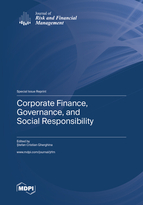Corporate Finance, Governance, and Social Responsibility
A special issue of Journal of Risk and Financial Management (ISSN 1911-8074). This special issue belongs to the section "Economics and Finance".
Deadline for manuscript submissions: closed (31 January 2023) | Viewed by 120410
Special Issue Editor
Interests: corporate finance; corporate governance; quantitative finance; sustainable development
Special Issues, Collections and Topics in MDPI journals
Special Issue Information
Dear Colleagues,
Corporate finance is the fundamental basis for the whole financial decisions of a company. It deals with the operation of the firm, both the sources of funding and the investment decision, the main purpose being shareholder value maximization, while harmonizing risk and profitability. Every corporation makes decisions that trigger financial repercussions and any resolution that entails money is delineated as a corporate financial decision. Nevertheless, the separation of ownership and control may rise potential agency conflicts as managers will pursue their own interest at the expense of stockholders. Corporate governance refers to the structures by which companies are managed and supervised. Good governance implies better oversight and greater transparency, which increase investor trust and lessen directors’ discretion. Well governed corporations are rewarded with enhanced operating performance and higher market valuation attributable to reduced agency costs. Boards are accountable for the prosperity of the company, their essential role being to fulfill the best interests of stakeholders. A diverse boardroom, covering gender, racial, and ethnic balance, stimulates innovation on account of various skills and experiences. Therewith, corporate social responsibility promotes firm’s image and augment its reputation, thus fostering long lasting relations with the customers.
Wide-ranging topics of interest cover, even are not limited to:
- Exploring the drivers of corporate default risk;
- Evaluating the connection between economic policy uncertainty and stock price crash risk;
- Analyzing the relationship among foreign ownership and company performance;
- Investigating the impact of CEO remuneration on firm risk;
- Examining the effect of board gender composition on dividend policy;
- Assessing the impact of pollutant emissions on firm performance;
- Inspecting the influence of corporate social responsibility on cash flow volatility.
Dr. Ştefan Cristian Gherghina
Guest Editor
Manuscript Submission Information
Manuscripts should be submitted online at www.mdpi.com by registering and logging in to this website. Once you are registered, click here to go to the submission form. Manuscripts can be submitted until the deadline. All submissions that pass pre-check are peer-reviewed. Accepted papers will be published continuously in the journal (as soon as accepted) and will be listed together on the special issue website. Research articles, review articles as well as short communications are invited. For planned papers, a title and short abstract (about 100 words) can be sent to the Editorial Office for announcement on this website.
Submitted manuscripts should not have been published previously, nor be under consideration for publication elsewhere (except conference proceedings papers). All manuscripts are thoroughly refereed through a single-blind peer-review process. A guide for authors and other relevant information for submission of manuscripts is available on the Instructions for Authors page. Journal of Risk and Financial Management is an international peer-reviewed open access monthly journal published by MDPI.
Please visit the Instructions for Authors page before submitting a manuscript. The Article Processing Charge (APC) for publication in this open access journal is 1400 CHF (Swiss Francs). Submitted papers should be well formatted and use good English. Authors may use MDPI's English editing service prior to publication or during author revisions.
Keywords
- accounting and stock market performance
- capital structure decisions
- firm risk
- ownership concentration
- foreign ownership
- state ownership
- CEO characteristics
- executive compensation policy
- boardroom diversity
- board independence
- board size
- audit, remuneration, and nomination committees
- corporate social responsibility strategy





